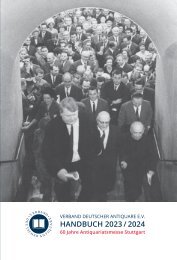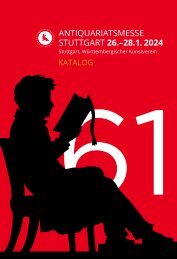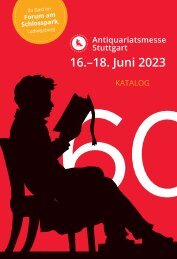Antiquariatsmesse Stuttgart 2021 - Katalog
Katalog zur Antiquariatsmesse Stuttgart 2021: Die Antiquariatsmesse Stuttgart als größtes Schaufenster für wertvolle Objekte des Antiquariats- und Graphikhandels in Deutschland findet in diesem Jahr in ungewohnter Form statt. Da eine Präsenzmesse nicht stattfinden kann, haben sich 76 Kollegen aus Deutschland, Großbritannien, Österreich, Frankreich, der Schweiz, den Niederlanden, den Vereinigten Staaten und aus Australien zusammengefunden, um einen Katalog für die Messe zu erstellen und gleichzeitig ein Angebot für eine virtuelle Messe zusammengetragen. Der Katalog wird am 7. Januar 2021 an interessierte Kunden verschickt, die virtuelle Messe öffnet ihre „digitalen Pforten“ am 29. Januar 2021 um 12.00 Uhr unter www.antiquariatsmesse-stuttgart.de
Katalog zur Antiquariatsmesse Stuttgart 2021: Die Antiquariatsmesse Stuttgart als größtes Schaufenster für wertvolle Objekte des Antiquariats- und Graphikhandels in Deutschland findet in diesem Jahr in ungewohnter Form statt. Da eine Präsenzmesse nicht stattfinden kann, haben sich 76 Kollegen aus Deutschland, Großbritannien, Österreich, Frankreich, der Schweiz, den Niederlanden, den Vereinigten Staaten und aus Australien zusammengefunden, um einen Katalog für die Messe zu erstellen und gleichzeitig ein Angebot für eine virtuelle Messe zusammengetragen.
Der Katalog wird am 7. Januar 2021 an interessierte Kunden verschickt, die virtuelle Messe öffnet ihre „digitalen Pforten“ am 29. Januar 2021 um 12.00 Uhr unter www.antiquariatsmesse-stuttgart.de
Sie wollen auch ein ePaper? Erhöhen Sie die Reichweite Ihrer Titel.
YUMPU macht aus Druck-PDFs automatisch weboptimierte ePaper, die Google liebt.
separately. The current sales value of this map today
probably is EUR 130 000,–.
This present edition is also interesting for the history of
Alpine exploration, containing Vadianus’ description of
the first ascent of mount Pilatus near Lucerne, accomplished
by him in the summer 1518 accompanied by
his humanist friends Johannes Xylotectus, Oswaldus
Myconius, and Conrad Grebel (p. 34). The importance
of Mela’s work, which Petrarca and Boccaccio held in
high esteem, which Cabal – the discoverer of Brazil
– worked through meticulously, and which has been
used as a schoolbook for centuries since early modern
times, is also evident to todays’s readers: Not only Trier,
the Taunus mountains, parts of the Lake Constance,
Scandinavia, etc. are mentioned here for the first time.
The architectural title border, signed and dated “1519
HF”, is attributed to Hans Furtenbach, a contemporary
of Urs Graf with whom he shares stylistic characteristics.
It shows the figure of “Hercules Gallicus” beneath
the title, the figures of Lucretia on the left and Judith
on the right, both standing above Andreas Cratander’s
Occasio-device. The head of the frame shows, from
left to right, the young Occasio again, an old woman
as Penitence, and a rich man. The frame of the title to
part II shows putti playing and sea monsters, in the
two vertical columns of grotesques Cratander’s Occasio.
This border in the style of Hans Holbein is most
probably by Hans Franck. Both borders were first
used by Cratander for his edition of Gellius’ “Noctes
Atticae” in 1519.
Charles Philipp Theodore Count of Pfalz-Sulzbach
(1724–1799), since 1777 Elector of the Palatinate branch
of the House of Wittelsbach, was a patron of the arts,
and the promoter of the first German National Theatre
at Mannheim, under the direction of Dalberg and
Iffland, and founder of the Mannheim Academy of
Sciences in 1763. He was a beautifier of the new capital
Mannheim and builder of the Castle of Schwetzingen.
After a separation of centuries he was able to reunite the
Palatinate with Bavaria and moved to Munich. – Ms.
library inscription on first flyleaf verso, small stamp
at foot of title, two tiny stains to title border, minor
spotting to first leaves, last text leaf with restored tear
in top margin slightly affecting the head-line, some
old ms. marginal annotations or underlinings. A very
fine copy in a unique binding. – VD 16 M 2314; Sabin
63957; JCBI, 82 (all copies without the map); Adams
M-1056; STC, (German), 608; Harrisse 112; Alden/
Landis 522/9; Hieronymus, Oberrhein. Buchillustration
II, 299 and 301, and illus. 320; cf. Brun I, 478 (on
Franck); Thieme/Becker XII, 345 („Die bekannteste
Arbeit, die Einfassung mit dem Hercules Gallicus“).
– See illustration.
Rétif de la Bretonne, Nicolas-Edme. Estampes de
Freude(n)berg pour le monument du costume. –
Estampes de Moreau de Jeune pour le Monument
du costume. Gravées par Dubounet. 2 vols. in 1.
With portrait of Freudenberger after Mind, engr.
title, engr. illus. table of contents, and 12 engr. plates
after Freudenberger; engr. portrait of Moreau after
Cochin, engr. title, engr. illus. table of contents,
and 24 engr. plates (2 suites) after Moreau le Jeune,
all present in 2 states, with tissue-guards bearing
short descriptions of the illustrations. XXIX,
224 pp.; XXIII, 104 pp., 3 leaves; engraved text
throughout. 4to. Contemp. red morocco, with triple
fillet around sides, spine richly gilt, double gilt
fillet on outer edges, inner dentelles, edges gilt
(by Chambolle-Duru). Paris, L. Conquet, 1881–
83. € 3800,–
No. 384 of 200 copies (291–490; épreuves terminés
4e état); and no. 111 of 70 copies (71–140; eaux-fortes
avancées 2e état), of a total edition of 490 copies, with
the ms. monogram of the publisher under both limitations.
Sigmund Freudenberger (1745–1801) was a
Swiss painter, studied as a portraitist and lived from
1765 to 1773 in Paris. He founded a private art school
in Bern and was known as “Little Master” for his
genre-like depictions of rural life. The plates of the
“Suite d’Estampes pour servir à l’Histoire des Moeurs
et Coutumes des François dans le 18e siècle” with the
charming, often gallant scenes were re-engraved by
Henri-Joseph Dubouchet, one of the leading engravers
of his time. Jean-Michel Moreau (1741–1814) was
a French draughtsman, illustrator and engraver. His
best-known works were illustrations for this costume
book, which was published for the first time in 1789.
Conquet published this present re-issue using the finest
available materials, creating a perfect sample of the
bibliophile taste of the 1880s. With text by Restif de
La Bretonne (1734–1806) and additional notes by John
Grand-Carteret and Philippe Burty. Although originally
published in the late 18th century, this suite to
illustrate the daily life of an aristocratic lady was one of
the rarest, most expensive, and most sought-after costume
works. “Parfaite reproduction, très rare et cotée,
de ses planches célèbres, fort bien gravées; elles ont eu
un très vif succès” (Carteret). – Nice copy attractively
bound by Chambolle-Duru, the leading 19th century
binding firm (signed). – Brivois 290–91 (listing the 24
Moreau plates); Vicaire VI, 1069–70; Carteret IV, 292;
Colas 1128–29.
Torah Scroll Bible. Manuscript on vellum. In Hebrew.
Ashkenazi square script in dark brown ink.
52–54 lines. 2 cols. 40 pieces of vellum sewn together
and rolled. 32 × 1600 cm. On old wooden handle
(some splittering, without heads). (N. pl., 19th century).
€ 5300,–
A rarely offered antique and complete desecrated handwritten
Torah. This manuscript scroll probably was
written in a Central European Jewish scriptorium in the
mid-19th century. The different sized vellum segments
measuring totally approx. 16 m or 52 ft in length are
written in the characteristic Ashkenazi square script.
This present manuscript contains the five books of
Moses called Pentateuch (Genesis, Exodus, Leviticus,
Numbers, and Deuteronomy), and is also known as
“chamischa chumsche tora”. – The impressive text
almost throughout in good condition, rich in contrast
and only minimally rubbed. Some holes in the vellum
closed, partly a little wavy and creased or stainings,
otherwise a fine example of Jewish piety.
247






